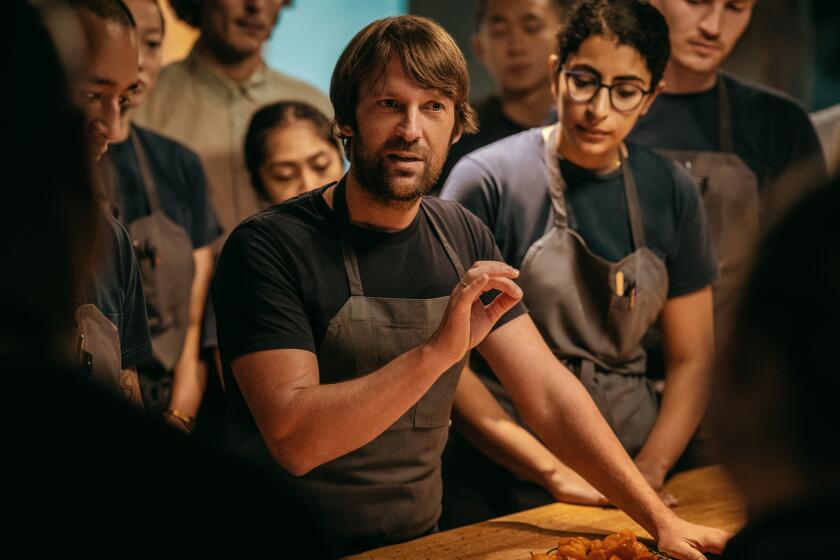How Would You Like a Punchnap?
The turnip is the ugly duckling of the vegetable kingdom. Try announcing to your family that you’re having turnips for dinner. You’ll be greeted by a chorus of groans. Children push them to the edge of their plates, and even many adults avoid them. Would anyone really go out of his way to eat a turnip?
Tony Ambrose would. He’s the owner of a swank new restaurant in Boston called Ambrosia. And he’s nuts about turnips.
Ambrose works all sorts of magic with turnips. He turns them to creamy purees, velvety soups and even translucent, snap-crackle-pop crisp chips. “A turnip is a blank canvas just waiting for culinary art,” Ambrose says.
The turnip to which Ambrose is most partial is a New England delicacy: the Macomber turnip. Named for an old Westport, Mass., family, Macomber turnips are grown almost exclusively in southeastern Massachusetts and Rhode Island. They are about the size of grapefruit, making them giants among root vegetables. The Macomber, with white flesh and a brownish crown, lacks the radish-like bite of other turnips; the flesh is amazingly sweet.
Macombers are the aristocrats of a family of root vegetables that includes the Eastham turnip (also called Cape Cod turnips, a kissing cousin of the Macomber), the gillfeather turnip (a large, sweet turnip from southern Vermont), the summer turnip (a small, radishy root you can eat raw in salads) and, of course, the familiar purple-topped turnip.
Closely related is the rutabaga, also known as Swede turnip, which is a cross between cabbage and turnip. Rutabagas were developed during the Middle Ages. They’re often confused with turnips, but it’s easy to tell them apart. Turnips have white flesh; rutabagas are yellow. Rutabagas have stronger flavor. The late Frank Zappa once sang an ode to the rutabaga on the album “Absolutely Free.”
And while we’re on the subject of turnips, let us not forget turnip greens. They have a tangy flavor reminiscent of watercress; the flavor mellows when cooked. Turnip greens are rich in calcium and Vitamin A and can be steamed, boiled or stewed with bacon and vinegar. I love them simmered in soup.
These sturdy root vegetables are incredibly versatile. Turnips can be boiled, steamed, braised, glazed and even baked in the skins like potatoes. They are delectable served whole or mashed, served fresh or as leftovers. Mild in flavor, they readily absorb the taste of herbs, spices, broth, cream and butter.
When buying turnips, look for firm, unblemished specimens, free of brown spots, soft spots or splits. Avoid turnips and rutabagas with leafy sprouts or shriveled skin. Rutabagas are waxed at the time of harvest to prevent them from drying out.
PUNCHNAP
Punchnap (turnip and potato puree) is loaded with cream and butter. To make a low-fat version, you could substitute chicken or vegetable stock for the butter (you’ll need 4 to 5 tablespoons) and no-fat sour cream for the whipping cream. Whisk the sour cream with 1 to 2 tablespoons stock to thin it to a pourable consistency.
1 pound turnips, peeled and cut into 1-inch pieces
1 pound potatoes, peeled and cut into 1-inch pieces
Salt
3 to 4 tablespoons butter
Freshly ground black pepper
3 to 4 tablespoons whipping cream
1 tablespoon finely chopped parsley
Place turnips and potatoes in separate pans. Cover each with salted cold water and slowly bring to boil. Cook each vegetable until soft, 5 to 8 minutes. Drain well.
Puree turnips and potatoes in food mill or with potato masher. (Do not use food processor or mixture will become gummy.) Beat in butter and salt and pepper to taste.
To serve, transfer puree to warm, shallow serving dish. Using wooden spoon, make several indentations in puree. Pour cream into them. Sprinkle with parsley and serve at once.
Makes 4 to 6 servings.
More to Read
Eat your way across L.A.
Get our weekly Tasting Notes newsletter for reviews, news and more.
You may occasionally receive promotional content from the Los Angeles Times.






